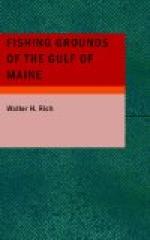The Gully is a very important halibut ground. The halibut are not found in great numbers all over the ground, perhaps the best of the fishing being on the rocky and gravelly ridges and slopes included between the meridians of 69 deg. and 80 deg. west longitude. This rocky bottom is rich in food, and the lant and herring are usually plentiful here in their season. In the spring the halibut seem to be especially numerous in the northern and northwestern parts of the bank, later, in June and July, moving farther out. Some, are found here in winter. While the cod is sometimes found in The Gully in 60 to 90 fathoms, it does not seem to be of regular occurrence; and apparently there are almost no haddock here, probably because of the depth of the water and the nature of the bottom.
Artimon Bank. Has an area of some 120 square miles with a bottom of gravel and rocks and depths of 38 to 50 fathoms. It is but little known because of the tendency of the fishermen to use the larger grounds close at hand. Cod are known to be present here, however. The bank lies N. of the eastern part of Quereau, separated from it by a narrow, deep-water channel.
Misaine Bank. Lies N. of the western two-thirds of Quereau, at one place very near, but in general the banks are separated by some 20 miles of deep water. Its greatest length is 80 miles and its greatest width 40 miles. Depths are from 40 to 60 fathoms over a bottom broken and rocky. It is not of much importance as a fishing ground, although a few halibut trips are landed from it in most years.
Canso Bank. A long, narrow extension of Misaine Bank, lying in an E, and W. direction; its length is 45 miles and its greatest width 13 miles, its area being about 425 square miles. Depths range from 30 to 65 fathoms over a bottom of sand, with spots of gravel and pebbles. It is not of much importance as a fishing ground, especially as judged by the use of it by the American fleet, though more fished by vessels from Nova Scotia; perhaps it is overshadowed by the presence of its larger neighbors, Western and Quereau Banks, with which grounds it forms virtually one piece of bottom, only narrow, deep-water channels separating them. These larger grounds are heavily fished both by American vessels and by those from Nova Scotia ports as well as by French and English otter trawlers.
The statistics given here and elsewhere in this report are taken from the published bulletins of the United States Bureau of Fisheries, and include only the landings of vessels of 5 tons net, or over, at the ports of Boston and Glouscester, Mass., and Portland, Me.
[Table 5—Fishing grounds of the offshore North Atlantic, showing the principal species taken upon them]
[Footnote 16: “Pedro Reinel, a Portuguese pilot of much fame” (Herrera) made a map in 1505 showing Sable Island, feared and dreaded by all fishermen even in those days, where he called it “Santa Cruz.” Jacamo Gastaldi, an Italian cartographer, in 1548 shows it “Isolla de Arena.” Sir Humphrey Gilbert or his historian, says that the Portuguese had made an interesting settlement here for shipwrecked mariners. This, “Upon intelligence we had of a Portugal who was himself present when the Portugals, above thirty years past (thus before 1551) did put upon the island neat and swine to breed, which were since exceedingly multiplied.”]




